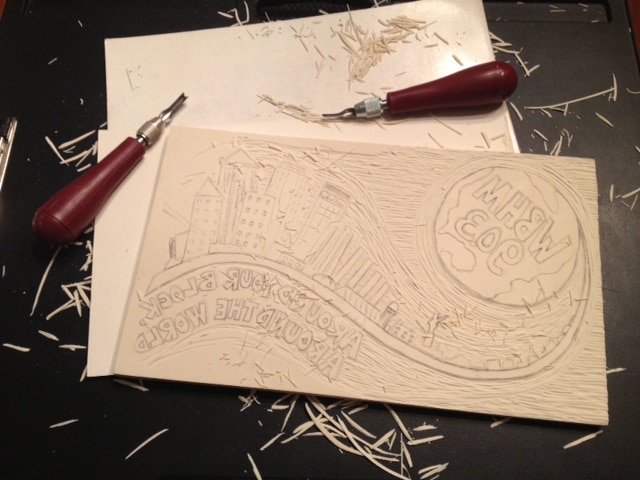Charles Buchanan: Around Your Block, Around the World
“The minute I heard that I had been selected as the artist for WBHM’s spring 2014 membership campaign, my mind started spinning with the creative possibilities. I had a great time hand-carving and hand-printing the piece, a fun and energetic ode to WBHM’s role in connecting listeners to important stories in the community and around the world. I’m excited that this print will help keep those stories flowing in our city.” —Charles Buchanan
Biography
Charles Buchanan was born in Selma, Ala., and lived all over the South before arriving in Birmingham, which he instantly adopted as his hometown. He began his career as an advertising copywriter before switching to magazine editing, and earlier this year, he was named editor of UAB Magazine. Charles has always been an artist, however, and while he grew up cartooning, he turned to printmaking as a way to capture the city’s texture and color.
With block printing—a technique he learned in elementary school—Charles creates bold graphic designs that bring new life to unique icons, highlight overlooked details, and exude a sense of place. To date he has carved more than 150 images, and his art has been featured on HGTV and Alabama’s state tourism web site, along with Birmingham magazine, B-Metro, and Vulture Whale’s debut CD. His work appears at Naked Art Gallery in Forest Park.
Charles is inspired by classic advertising, letterpress printing, and roadside Americana—particularly the faded painted wall signs of downtown Birmingham. His book, Fading Ads of Birmingham, published in 2012 by the History Press, reveals the fascinating stories behind many of these “ghost signs” and illuminates their important roles during the city’s rapid growth.
Recently, Charles has been blending his block prints with screenprints, watercolor painting, and drawing. He and his wife, Carrie Beth, are also eagerly awaiting the arrival of their first child, Claire, this May.
Block Printing
This block print began with an original drawing, which Charles refined using tracing paper. He moved the image to a rubber block by placing the paper face down onto the block and rubbing the back of the paper. The pencil lines transferred easily, giving him guides as he used U- and V-shaped metal gouges to carve away every part of the block that he did not want to see in the print. Every line you see in the image—and everything that’s not a color, in fact, has been carved away by hand. Charles then rolled ink onto the block and pressed paper on top of it to create the final printed image.
Because each of his block prints is printed individually and by hand, no two prints are ever exactly alike. “I enjoy layering, mixing, and ‘ghosting’ the images to create one-of-a-kind pieces that feel both vintage and modern,” says Charles. “It feels like drawing, sculpture, printing, and painting all in one.”

